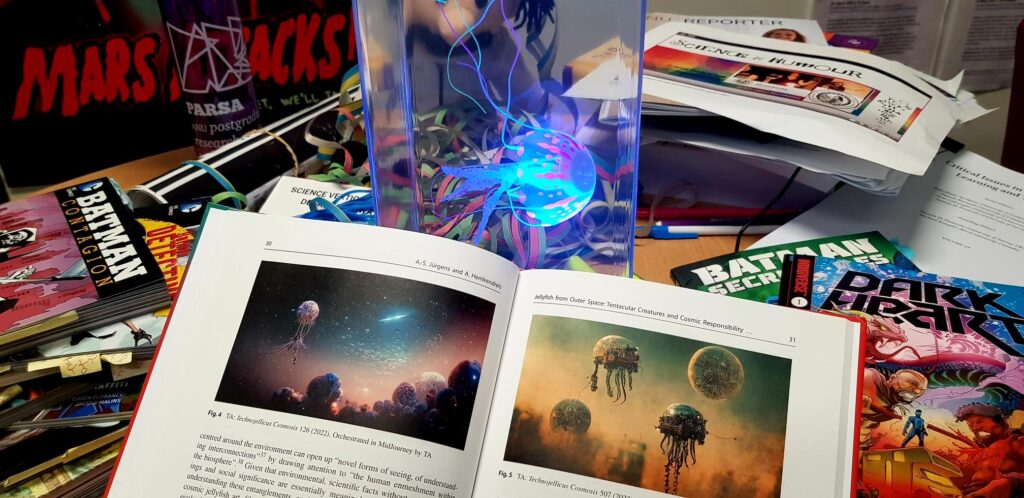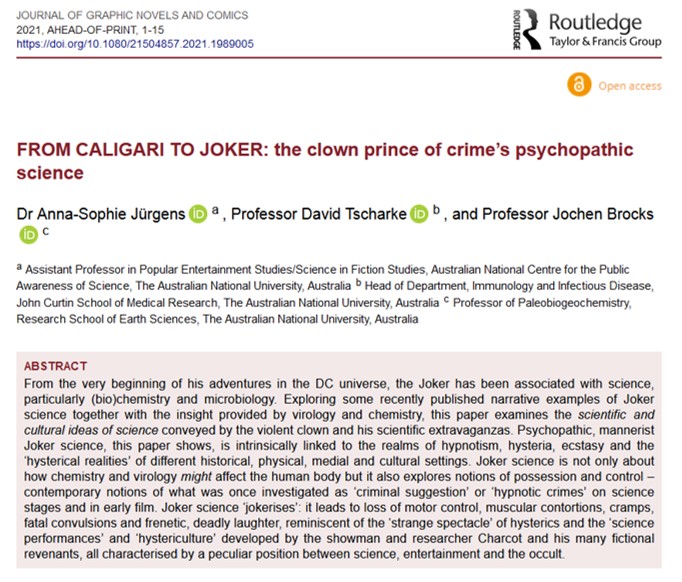Popular cultural products, such as fictional films or comic book stories, and popular entertainment (including circus, cabaret and comedy shows), are vehicles of science and environmental communication: They reflect ideas and fantasies about our environment and science, but also shape public perceptions and attitudes towards science and research. To better understand these cultural meaning-making processes (and their results), the POPSICULE explores representations of scientists in fiction, entertainment and popular media with a special focus on the following themes...
Cultural Meanings of Science
Most people are not scientists. Many of them encounter images of science through depictions in popular culture. Popular depictions of science can significantly influence public attitudes towards science by forming, cultivating or reinforcing the cultural meanings of science. Therefore, popular culture is a versatile frame for interpreting our relationship with science, and pop cultural products – such as (animated) film and comic book stories – are vehicles of science communication.
Pop culture media are receiving increasing attention as a means of science communication and education. They explore and use “the mirror images of science or scientists in the collective imagination” (Hüppauf/Weingart) and thus provide us with cultural meanings and images of science outside the framework of science.
Pop cultural products examining science themes as a form of media cultural “public pedagogy” (Giroux) can instil enjoyment and other affective responses and experiences (such as amusement) in relation to the science at stake, and form, reform or confirm science-related opinions.
Explorations of science in popular media can discover and exploit major overlooked cultural themes, shape new intellectual agendas and public cultural discourses, identify weird and wonderful visions of our scientific humanity which have evaded cultural debate, create new knowledge about our science-society relationships and elucidate the contribution of science communication to new understandings of cultural history.
The impact can be on our adaptability to a future that requires not only scientific facts but also engaging communication to address our global challenges.
Studying science in culture advances society’s knowledge about the cultural power and human experience of science.
Environmental Awareness and Pop Culture, Popular Arts & Aesthetics
Across our different research and engagement streams, we are interested in exploring science & environmental knowledge in pop culture, our place in the natural world & our responsibility towards non-human species through aesthetic experience. We develop alternative scenarios and imaginaries to the effects and legacies of the fable of human exceptionalism – to drive meaningful change.
Representations of Scientists in Culture
Scientists seek to investigate the ways in which nature works and to ask how humanity can best comprehend different aspects of the universe and domesticate the unknown. By challenging conventional wisdom, scientists can act as rebels against the status quo and common sense. In what ways do scientists appear in cultural and fictional contexts? What can we learn about science in society from fictional representations of scientists? And how can we challenge the ubiquitous stereotype of the lab coat-wearing science weirdo? – and thus contribute to a change of perspective?!
Together with our students, we are particularly interested in how stereotypes of scientists, female scientists in particular, are challenged through humour. Here is an example of our research:

Science in Popular Fiction
Science appears in popular fiction in multiple guises, from allegorical explorations of future technologies in science fiction through to characters’ health crises in soap operas. Key questions science communicators ask about fiction is: Does it reflect public ideas about science, or direct them? How do people use fiction as a resource to work through their questions about science? Our research shows people mostly do not believe the science they see and read in fiction, because they are aware that fiction can take liberties with the truth. But when is that not true? And what kinds of truths can fiction communicate about science?
Fiction has been used for many practical purposes in the science communication realm. All kinds of films from Star Wars to The Blues Brothers have been used to teach science in the classroom. Well-loved television dramas including the UK’s Coronation Street and the pan-African multi-media Shuga series have successfully communicated health messages with audiences all over the world. Fictional characters like Star Trek’s Lieutenant Uhura and NCIS’s Abby Sciuto have been used to recruit people from marginalised genders and ethnic backgrounds to science-related careers. CSI and even Harry Potter have been the basis of travelling exhibitions in science centres and museums. Technologies shown in sci-fi films like Minority Report have built interest in technologies that engineers would like to create, and attracted funders to pay them. Scientists have lobbied politicians for funding into Near Earth Objects by capitalising on the disaster movies Deep Impact and Armageddon. Even inaccurate science provides a great opportunity for scientists to promote interest in their science, for example Jurassic Park’s featherless dinosaurs sparked immense public discussion about dinosaur biology. At the POPSICULE we are interested in research in any of these areas, and through our teaching, workshops and outreach we train new generations of science communicators to use fiction as a core tool.
Fiction may help general as well as scientist readers to find new ways of engaging with ‘science and society’ in both directions: in relation to the role and relevance of science in various forms of social settings, and also in relation to the role of social, individual, and cultural factors built into the practise of science for whose critical analysis and discussion scientific discourses themselves provide little space. The construction of complex scientist characters as problematic individuals appears as the privileged device for realising this potential.
Kirchhofer/Roxburgh – find out more in The Matter of Fact: Science and Identity in Contemporary Australian Literature
Aliens and Space Exploration in Science Fiction and Pop Culture
‘Aliens’ are a common trope across science fiction. Yet, until very recent times, alien life is a topic that has little scientific backing – never have we encountered, discovered or found clear evidence for any sort of life beyond Earth. Yet, now more than ever, aliens are rife in popular fiction while billions of dollars are being invested in programs to search for signs of life, including intelligent life. What is the history of aliens in fiction, and how have these portrayals impacted the search for and increase of technology in the search for aliens?
Images of outer space and aliens are ubiquitous in popular culture – in film and fiction, but also in popular music. What do these pop cultural interpretations and fantasies tell us about our cultural understanding and popular imagination of space, space exploration and science?

Science in Comics and Animated Films
If you have always wondered where to study science and technology in comics and animated film at the ANU, you found the right place! We explore such questions such as: How can we use the Joker – ‘spreading’ laughter in DC comics and animated films – to teach virology? How does the staging of evolutionary theory in 19th-century ‘freak shows’ reappear in the Hulk (2003)? And how can our own comics about science be used as a science communication tool?


Together with our international collaborators and students, we are particularly interested in the power of comics and animated films – and more generally popular art and aesthetics – to communicate ENVIRONMENTAL URGENCY AND FRAGILITY.
STAGES OF WONDROUS SCIENCE: Science, Circus and Popular Entertainment
One of the most productive breeding grounds for the invention, amalgamation, and staging of scientific knowledge and creative imagination is the circus and related cultural phenomena, such as so-called ‘freak shows’, carnivals, and 19th century ‘scientific’ museums. These sensational, kaleidoscopic institutions present(ed) manifold wondrous exhibits, including living automatons, magical lanterns, wax figures, extra-terrestrials and mummies, but they also presented scientific discoveries. Oscillating between respectability and fraud, science and deception, ritualised exposé and aesthetic cover-ups, they made hundreds of previously unseen phenomena – including scientific specimens – accessible to a broad audience.
Exhibitions and shows of this type united science with mystery, acted as mediators of knowledge, and were often the primary public source of information about the current state of scientific research. Their imaginaries and hyperbolic aesthetics live on in contemporary science and magic shows, movies and fiction. They are reminders that science and its pursuits are matters of perspective, and the product and producer of good stories. What do these stories tell us about scientific achievements – and the ‘two cultures’ of the humanities and science?

Science and Humour
Humour is not only one of the most powerful tools in communication, but it also shapes cultural ideas of sciences. We study contemporary and historical cultural examples to clarify how comic cultural narratives about science have affected the public discourse and understanding of science.
What does comic performance offer to understanding the public image and pop cultural narratives of science? How can humour – and what kind of humour – be used in science communication? What can we learn about science from comic scientists such as those in the Nutty Professor films or comic Frankenstein stories? What can we learn from the interplay between forensic science and comic zombies in splatstick films (from Braindead or Zombieland to iZombie) for the communication of science?
Humour and laughter are great ways to bring science to the public. However, humour and comedy as part of public discourse about science and science-based public culture have been conspicuous by their absence in science communication teaching at the ANU, despite a growing interested in humorous public science events, science stand-up routines, etc. We are thus offering students new insights in how to apply and communicate their science knowledge more effectively through humour, e.g. when communicating with a range of different stakeholders, while also promoting awareness of good practice and responsible, versatile use of nuanced humour in science contexts.
Explore science and humour in culture with us or develop your own creative humour-based science communication project!
Humour and laughter do not necessarily go hand in hand. What does our favourite cultural nightmare, the Joker, and Todd Phillips’s 2019 Joker blockbuster teach us about clowning and neurology?




